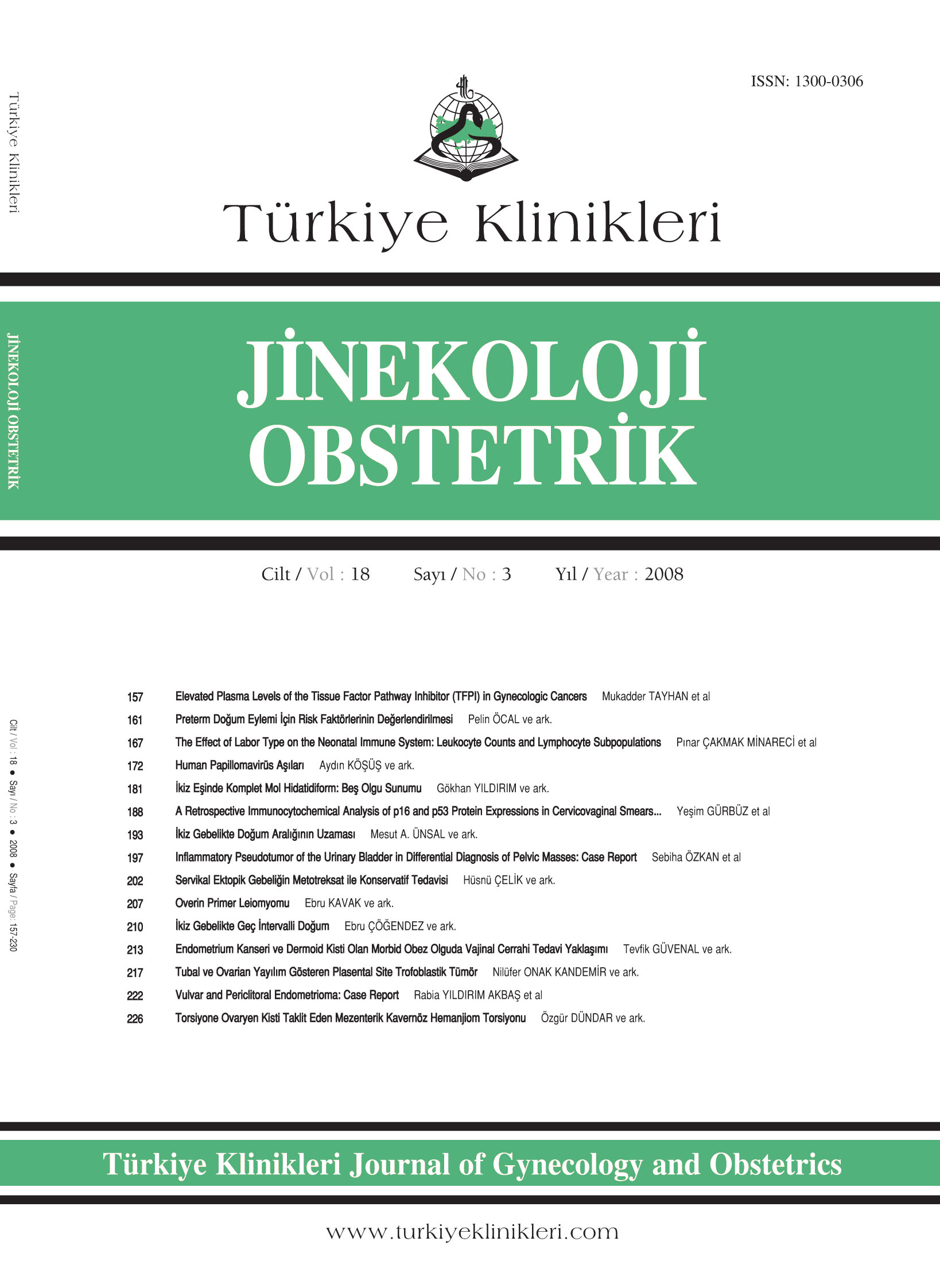Open Access
Peer Reviewed
CASE REPORTS
4306 Viewed1202 Downloaded
Delayed Interval Delivery in Twin Pregnancy: Case Report
İkiz Gebelikte Doğum Aralığının Uzaması
Turkiye Klinikleri J Gynecol Obst. 2008;18(3):193-6
Article Language: TR
Copyright Ⓒ 2025 by Türkiye Klinikleri. This is an open access article under the CC BY-NC-ND license (http://creativecommons.org/licenses/by-nc-nd/4.0/)
ÖZET
Erken doğum, çoğul gebeliklerin en önemli komplikasyonudur ve prematür membran rüptürü, intrauterin gelişme geriliği ve intrauterin fetal ölümle birliktedir. İlk fetusun doğumunu genellikle diğer fetus veya fetusların doğumu takip eder. Bazı vakalarda ise ilk fetusun doğumunu takiben uterin kontraksiyonlar durur ve ikinci fetusun doğumu gecikir. 18 yaşında, gravida 2, para 2, son adet tarihine göre 24 hafta 2 günlük spontan ikiz gebeliği (dikoryonik diamniotik) olan olgu prematür eylem yüzünden spontan vaginal yol ile 700 gram bir adet kız bebek doğurmuş. Olgumuzda ilk fetusun doğumunu takiben uterus kontraksiyonların durması ve ikinci fetusun doğumunun gerçekleşmemesi nedeni ile onuncu güne kadar hastanede izlemde preterm eylem ve erken membran rüptürü sebebiyle 600 gram canlı kız bebek doğurtuldu. Hastanın postpartum dönemde problemi olmadı. Her iki bebek de yenidoğan yoğun bakım ünitesinde prematürite ve respiratuar distress sendromu tanıları ile izleme alındı. Fetal ve maternal durumun yakın takibi ile doğum aralığının uzatılması ikinci fetusun morbidite ve mortalitesinin azaltılmasına katkıda bulunabilir ve plasenta retansiyonuna rağmen maternal açıdan da nispeten güvenli bir yaklaşım olabilir.
Erken doğum, çoğul gebeliklerin en önemli komplikasyonudur ve prematür membran rüptürü, intrauterin gelişme geriliği ve intrauterin fetal ölümle birliktedir. İlk fetusun doğumunu genellikle diğer fetus veya fetusların doğumu takip eder. Bazı vakalarda ise ilk fetusun doğumunu takiben uterin kontraksiyonlar durur ve ikinci fetusun doğumu gecikir. 18 yaşında, gravida 2, para 2, son adet tarihine göre 24 hafta 2 günlük spontan ikiz gebeliği (dikoryonik diamniotik) olan olgu prematür eylem yüzünden spontan vaginal yol ile 700 gram bir adet kız bebek doğurmuş. Olgumuzda ilk fetusun doğumunu takiben uterus kontraksiyonların durması ve ikinci fetusun doğumunun gerçekleşmemesi nedeni ile onuncu güne kadar hastanede izlemde preterm eylem ve erken membran rüptürü sebebiyle 600 gram canlı kız bebek doğurtuldu. Hastanın postpartum dönemde problemi olmadı. Her iki bebek de yenidoğan yoğun bakım ünitesinde prematürite ve respiratuar distress sendromu tanıları ile izleme alındı. Fetal ve maternal durumun yakın takibi ile doğum aralığının uzatılması ikinci fetusun morbidite ve mortalitesinin azaltılmasına katkıda bulunabilir ve plasenta retansiyonuna rağmen maternal açıdan da nispeten güvenli bir yaklaşım olabilir.
ANAHTAR KELİMELER: Çoğul gebelik; doğum aralığı
ABSTRACT
Preterm delivery remains the most important complication of multiple gestation, besides the risks of preterm premature rupture of membranes, intrauterin growth restriction and intrauterin fetal death. The birth of the first twin is usually followed by the unavoidable delivery of the following child or children. In some cases, uterin contractions stop once the first foetus is expelled and the delivery of second fetus is delayed. An 18-year-old, gravida 2, para 2 woman at 24 week 2 days spontaneous twin gestation (dichorionic diamniotic) had the history of spontaneous vaginal delivery of 700 g female fetus two days ago and was referred for further evaluation of undelivered second twin. Following delivery of first one twin, the uterine contractions have ended and the delivery of second has delayed. On the tenth day of follow-up, the second one twin (600 g live female fetus) was delivered via vaginal route because of uneventful preterm labor and preterm premature rupture of membranes. The postpartum period was unremarkable. Both fetuses were followed in newborn intensive care unit because of prematurity and respiratuar distress syndrome. The delayed interval delivery of second twin in combination with close monitoring of fetal and maternal well-being may contribute to the decrease in perinatal mortality and morbidity of second one twin, and this management may be safe for also mother even in the presense of placental retantion of first fetus.
Preterm delivery remains the most important complication of multiple gestation, besides the risks of preterm premature rupture of membranes, intrauterin growth restriction and intrauterin fetal death. The birth of the first twin is usually followed by the unavoidable delivery of the following child or children. In some cases, uterin contractions stop once the first foetus is expelled and the delivery of second fetus is delayed. An 18-year-old, gravida 2, para 2 woman at 24 week 2 days spontaneous twin gestation (dichorionic diamniotic) had the history of spontaneous vaginal delivery of 700 g female fetus two days ago and was referred for further evaluation of undelivered second twin. Following delivery of first one twin, the uterine contractions have ended and the delivery of second has delayed. On the tenth day of follow-up, the second one twin (600 g live female fetus) was delivered via vaginal route because of uneventful preterm labor and preterm premature rupture of membranes. The postpartum period was unremarkable. Both fetuses were followed in newborn intensive care unit because of prematurity and respiratuar distress syndrome. The delayed interval delivery of second twin in combination with close monitoring of fetal and maternal well-being may contribute to the decrease in perinatal mortality and morbidity of second one twin, and this management may be safe for also mother even in the presense of placental retantion of first fetus.
MENU
POPULAR ARTICLES
MOST DOWNLOADED ARTICLES





This journal is licensed under a Creative Commons Attribution-NonCommercial-NoDerivatives 4.0 International License.










